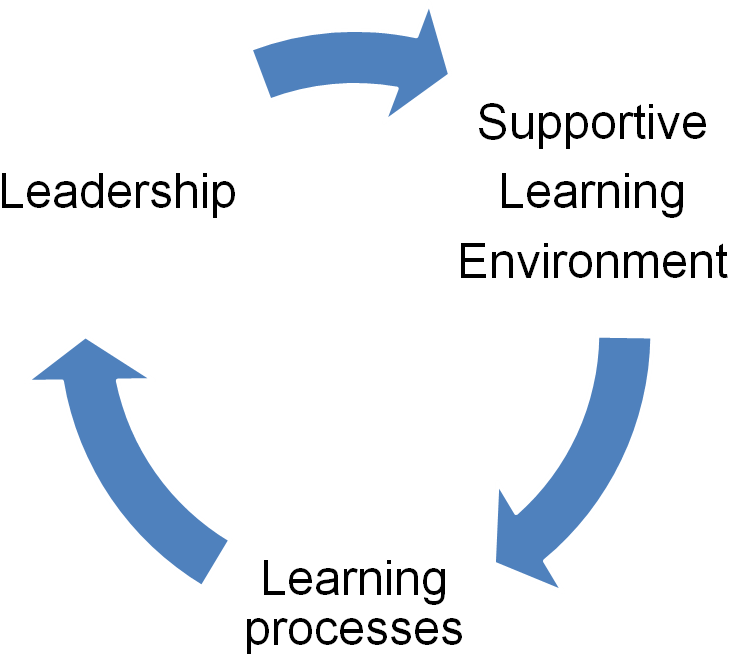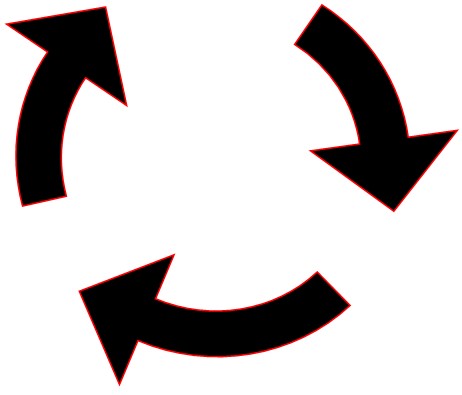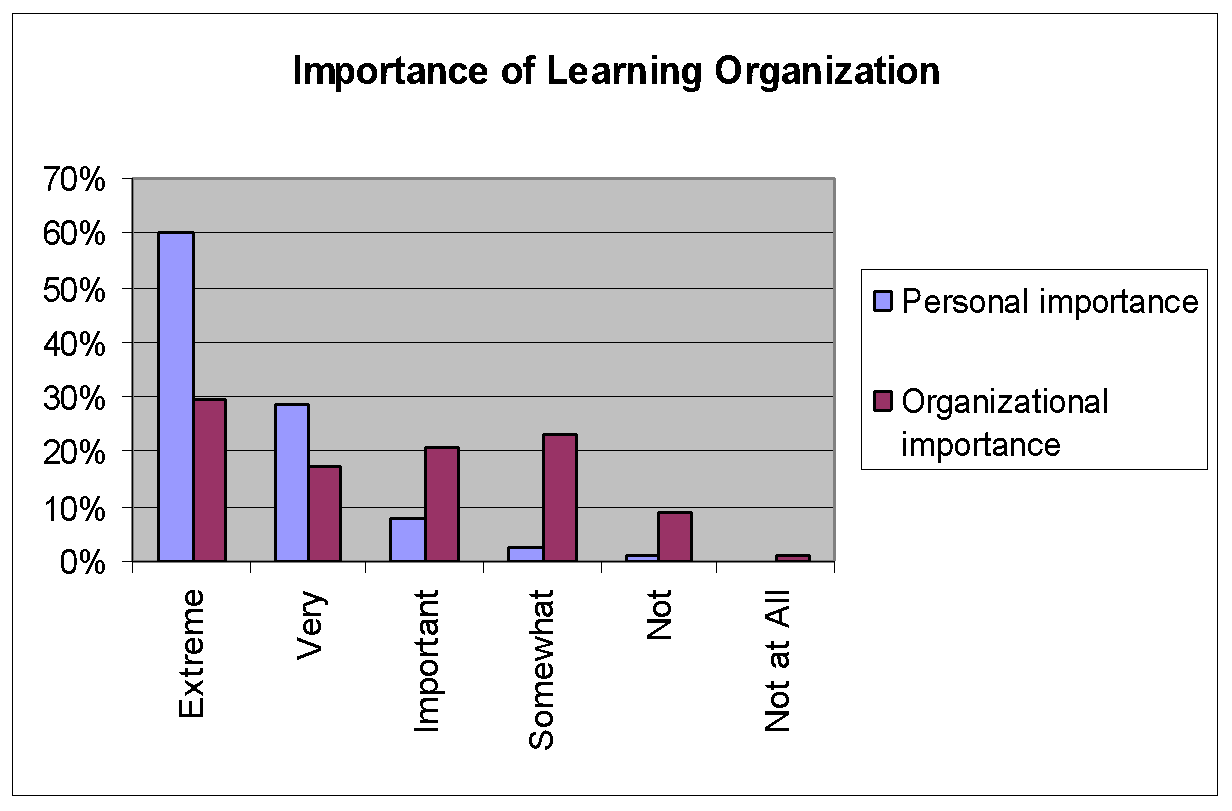Introduction
Issues that concern Leadership in Learning organizations are going to be reported in the project. It includes much information about this subject concerning the definitions, reasons for emergence, characteristics, and managerial implications. Afterward, it points out some advantages and disadvantages of this specific subject. It continues with controversies and approaches. In the end, I conclude my opinion and comments and also some parts that are “worth” being mentioned once again. During the 1990s, the concept of the learning organization was much discussed and argued about. There are many arguments written about leadership in learning organizations as we will mention below.
Definition of Leadership and Learning organization
A “learning organization” has been defined in different ways by authors. According to Garvin (1993), a learning organization can be defined as “an organization skilled at creating, acquiring, and transferring knowledge, and at modifying its behavior to reflect new knowledge and insights” (Garvin, 1993, p.80). A large number of scholars consider organizational learning as a process, a “cognitive enterprise that unfolds over time, but they differ on other important matters” (Sinkula, Baker & Noordewier, 1997, P. 305). Some of these scholars hold a belief that there is a need to have behavioral change for learning (Fiol & Lyles, 1985); other scholars maintain that fresh ways of thinking are sufficient (Huber, 1991). And still, there are those who emphasize solid “market information processing systems as being a means through which learning occurs” (Sinkula, 1994).

It is pointed out that Woolner’s stage five learning organizations still remain “a distant vision until leadership capabilities they demand are developed” (Senge, 1990, p.22). But the question is, “what are these leadership capabilities, and how specifically can they be developed?” (Johnson, 1998, p.144). It was noted by Bennis (1987) that “leaders are people who do the right things, managers are people who do things right (Bennis, 1987, p-.19). The “leadership” concept is almost as unclear as to the “learning organization” one. Wheatley (1992) refers to leadership as “an amorphous phenomenon that has intrigued us since people began studying organizations” (Wheatley, 1992, p.12). A leader of a learning organization should be the one who “fosters, cultivates, and sustains individual and organizational learning”

Emergence and Characteristics of a Learning Organization
It is pointed out that a learning organization is an organization that is in a position to engage in behavior and mindset change as a consequence of experience (Mitleton-Kelley, n.d). However, a large number of organizations do not accept to acknowledge particular facts, and they repeatedly engage in dysfunctional behaviors. It is also pointed out that creating learning environments that make it easy to achieve some specific goals tend to boost “learning and leadership at all levels and this is likely to make the organization to be more accountable for its actions as individuals tend to accept more readily responsibility for their actions” (Mitleton-Kelley, n.d., p.1). The organizations, in the private as well as public sectors, which have been taken on this approach, realize that the level of individual responsibility goes up considerably and accountability turns out to be stronger and clearer. They as well come to find out that they develop “true distributed leadership since every individual is a responsible agent working towards a common vision, exploring possibilities and taking initiatives that nevertheless fit well into the overall strategic direction” (Maguire & Mckelvey, 1999, p.20) This is accomplished by the learning organization through having a well-established network of “relationships and peer support” (Mitleton-Kelley, n.d, p.1).
Organizational learning is bigger than individual learning and comes up through “the interaction of individuals in groups and teams of different sizes” (Mitleton-Kelley, n.d., p.1). It is pointed out that “what is characteristic of organizational learning is that it is an emergent process in the sense that its outcome is not predictable and is more than the separate contributions of individuals” (Mitleton-Kelley, n.d., p.2). In order for organizational learning to flourish, there is a need to have the right environment which gives room for reflecting on the actions that occurred before as well as the outcomes that were realized. Moreover, an environment is to be ready to agree to some unpleasant truth which is not a “blame culture in the sense that mistakes are unacceptable” (Mitleton-Kelley, n.d., p.1). An environment of this kind distinguishes between the mistakes which are a consequence of irresponsibility and lack of foresight as well as a legitimate exploration of fresh ideas or a new way of doing things. In case some people or teams are given encouragement to become innovative, they should engage in exploring alternatives and taking well-thought-out risks. However, success will not be attained in all the experiments. In order to achieve success, there is a need to try several experiments. The “failures’ that are encountered are not supposed to be regarded as mistakes but rather as genuine explorations of “the space of possibilities, as part of the search to find new, innovative products, procedures, ways of working, and so on” (Mitleton-Kelley, n.d., p.1).
According to Mitleton-Kelley (n.d), in the course of the learning process, people will engage in influencing one another, and the ideas they will have will co-evolve; “each idea will adapt and change in the context of other ideas, and once changed, it will, in turn, have an influence on what happens next” (Mitleton-Kelley, n.d, p.2). The “co-evolution” concept is very strong and applicable not just to the internal organizational learning but to strategy as well in connection to an ever-changing environment and also to understanding sustainability.
While the wider environment changes, the policies, actions and procedures are supposed to offer a response to these changes within the environment. The moment they change, they will subsequently have an influence on a wider environment. It is pointed out that “when the influence and change are reciprocal and not unilateral, then co-evolution has occurred” (Mitleton-Kelley, n.d, p.2).
Any learning organization boosts self-organization in order for the groups to be able to converge to engage in the exploration of fresh ideas without having directions from the manager outside the group to carry out this. This is a process that takes place in a natural way, but the learning organizations give encouragement in an active way to have self-organization and do not consider this as a way of wasting time. This is a very vital part of the innovative process that is also an essential part of bringing about an environment that makes it easy to have “co-evolution sustainability” (Mitleton-Kelley, n.d, p.2).
Learning organizations encompass “multiple and intricate networks or relationships, which are sustained through communication and other forms of feedback, with varying degrees of interdependence” (Mitleton-Kelley, n.d,.p.2). Even if these organizations are greatly influenced by history, they have gone through their culture and are able to rise above these two when it is required. When organizations of this nature come across some constraints, they are in a position to engage in the exploration of the “space of possibilities” and come up with a fresh way of carrying out their activities, thus they embrace innovation and creativity and get a new thing. This “creation of new order” is the “distinctive characteristic of complex systems” (Mitleton-Kelley, n.d., p.2) But unluckily, this inherent innovation source is, most of the time, restricted. Having clear knowledge about “the characteristics of complex systems and complex learning organizations means that we can work with those characteristics to achieve objectives, rather than against them” (Mitleton-Kelley, n.d,., p.2).
In a global survey that was conducted by Dewar & Whittington (2003) concerning the importance of learning organizations, the following results were obtained:

Managerial Implications of Leadership in a Learning Organization
Peter Senge presents an argument that learning organizations are supposed to have a fresh view of leadership. This researcher considers the traditional view of leaders as “special people who set the direction, make key decisions and energize the troops as deriving from a deeply individualistic and non-systematic worldview” Senge, 1990, p.340). At its core, the traditional view of leadership is formed on the basis of “assumptions of people’s powerlessness, their lack of personal vision and inability to master the forces of change, deficits which can be remedied only by a few great leaders (Senge, 1990, p.340). Contrary to this traditional view, Senge develops a fresh view of leadership which focuses on “subtler and more important tasks” (Senge, 1990, p.340).
It is pointed out that in a learning organization, the leaders are teachers, stewards and designers (Smith. 2001). These leaders have the responsibility of building organizations in which people constantly enlarge their abilities to have the understanding of complexity, make the vision clearer, and carry out improvement of the “shared mental models….learning organization will remain a ‘good idea’ until people take a stand for building such organizations…taking this stand is the first leadership act, the start of inspiring the vision of the learning organization” (Senge 1990, p.340).
Considering the leader as a designer, Senge (1990) presents an argument that the design functions are not often seen yet no person has “a more sweeping influence than the designer” (Senge, 1990, p.341). The policies, as well as systems and strategies put in place by an organization, are the main area of design, but leadership is bigger than this. It is important to bring together five component technologies. However, the initial task involves designing the controlling ideas. The task of the leader is to design “the learning processes whereby people throughout the organization can deal productively with the critical issues they face, and develop their mastery in the learning disciplines” (Senge, 1990, p.345).
In considering leaders as teachers while they obtain inspiration as well as spiritual reserves from the sense of stewardship they have, it is pointed out that “much of the leverage leaders can actually exert lies in helping people achieve more accurate, more insightful and more empowering views of reality” (Senge, 1990, p.353). Senge (1990) presents an argument built on the “hierarchy of explanation” that leaders are able to engage in influencing the view people have concerning reality, basically at fours levels, which include “systematic structures, events, behavior patterns and purpose story” (Senge, 1990). Managers and leaders have a tendency to put much focus on the events and behavior pattern levels. In the learning organizations, the leaders consider all the fours levels but largely focus on the systematic structure and purpose. In addition, they engage in teaching people in the entire organization to do the same. This enables them to be in a position of seeing the big picture and “to appreciate the structural forces that condition behavior” (Smith, 2001, p.1). By considering purpose, the leaders of the learning organization are able to develop an understanding of what the organization is striving to become. Among the major issues, here is the fact that leaders, most of the time, do possess strengths in at least one area but are not in a position, for instance, to set up “systematic understanding” (Smith, 2001). Senge (1990) points out that “a key to success is being able to conceptualize insights so that they become public knowledge, open to challenge and further improvement” (Senge, 1990, p.356).
Controversies and Approaches to leadership to a learning organization
According to Johnson (1998), the central question is: “what types of leadership qualities are needed in learning organizations?” (Johnson, 1998, p.145). He points out that two assumptions are in order. The first assumption is that learning organizations need to have “different leadership qualities from traditional organizational models” (Senge, 1990, p.339). The other assumption is that in learning organizations, leadership is required from the top of the organization. It was stated by Argyris (1991) that top management has to have “ownership of change initiatives to prevent the ‘not invented here syndrome” (Argyris, 1991, p.106). It was pointed out by Watkins and Marskin that active participation from the top management is needed in order to successfully effect change; they also point out that “learning organizations can not be built from within the training department” (Watkins and Marskin, 1993, p. xvii).
However, this does not imply that the leaders who are at the top management positions in the organization engage in directing every person in the organization. It was stated by Senge (1990) that a single person can not “learn for the entire organization the same way such people as Henry Ford and Tom Watson once were able to do” (Senge, 1990, p.330). The scholar repeated this view in his description of the “traditional Western view of leadership” (Johnson, 1998, p.145). He pointed out that the ideas are obtained from the heads of the people who are in the top management positions and in turn implanted in the heads of the people who are at the bottom level of the organization.
However, on the other hand, some researchers like Redding and Catalanello (1994) do not agree with this viewpoint. They come up with a recommendation that “pockets of learning can form within the organization and may be shared with the rest of the organization” (Redding and Catalanello, 1994, p10). They make an assertion that change can come about in the separate parts of the organization, and they also go ahead to point out that people in the top management positions do not essentially have to command change for it to come about.
Researchers offer a wide range of views in regard to leadership requirements in learning organizations. For instance, Barrow and Laughlin (1992) found out four major responsibilities which include “creating a vision, creating an atmosphere of trust, scanning the environment for threats and opportunities, and developing employees” (Barrow and Laughlin, 1992, p.6).
Conclusion
A learning organization is able to change behavior and mindset change following the experience it has acquired. But several organizations do not accept the acknowledgment of particular facts, and they repeatedly engage in dysfunctional behaviors. Setting up learning environments, which facilitate accomplishing some specific objectives, tend to support learning and leadership at all levels, and this is likely to make the organization more accountable for its actions since it is likely to accept responsibility for the actions it engages in more readily. The leaders in the learning organizations are teachers, stewards and designers. They are charged with the responsibility of setting up organizations where individuals expand the abilities they are to understand the complexity and have a clear vision of the issue.
References
Argyris, C. (1991). Teaching smart people how to learn. Reflections 4(2), 4-15. Web.
Barrow, M. J., & McLaughlin, H. M. (1992). Towards a Learning Organization: 1. The Rationale. Industrial and Commercial Training, 24 (1), 6. doi: 10.1108/EUM0000000001588.
Bennis, W. (1987). The four competencies of leadership. School Library Media Quarterly 15(4), 196-199.
Dewar, T., & Whittington, D. (2003). Best practices of learning organizations results of a global survey. [PowerPoint slides]. Web.
Fiol, C. M., & Lyles, M. A. (1985). Organizational Learning. Academy of Management Review 10 (4), 803-813.
Garvin, D. A. (1993). Building a Learning Organization. Harvard Business Review 71 (4), 78-91.
Huber, G. P. (1991). Organizational Learning: The Contributing Processes and the Literatures. Organization Science, 2 (1), 88-115. Web.
Johnson, J. R. (1998). Embracing change: a leadership model for a learning organization. Journal of International Training and Development, 2(2), 141–150.
Maguire, S., & McKelvey, B. (1999).Complexity and Management: Moving from Fad to Firm Foundations. Emergence, 1(2), 19-61. doi: 10.1207/s15327000em0102_3.
Mitleton-Kelley, E. (n.d). What are the characteristics of a learning organization?
Pacific Ocean Division. (2007). USACE Leadership development Programme: Developing Leaders at All Levels. Web.
Redding, J. C., & Catalanello, R. F. (1994). Strategic Readiness: The Making of the Learning Organization. San Francisco: Jossey-Bass.
Senge, P. M. (1990). The Fifth Discipline: The Art and Practice of the Learning Organization. New York: Currency Doubleday.
Sinkula, J. M. (1994). Market Information Processing and Organizational Learning. Journal of Marketing 58 (1), 35-45. Web.
Sinkula, J. M., Baker, W. E., & Noordewier, T. (1997). A framework for market-based organizational learning: Linked values, knowledge and behavior. Journal of the Academy of Marketing Science, 25 (4), 305 – 318.
Smith, K. M. (2001). Peter Senge and the learning organization. In The Encyclopaedia of Informal Education. Web.
Vedpuriswar, A. V. (2008). Building a learning organization. Web.
Watkins, K. E. & Marsick, Victoria, J. (1993). Sculpting the Learning Organization: Lessons in the Art and Practice of a Systemic Change. San Francisco: Jossey-Bass.
Wheatley, M. J. (1992). Leadership and the New Science: Learning About Organizations from an Orderly Universe. San Francisco: Berrett-Koehler Publishers.